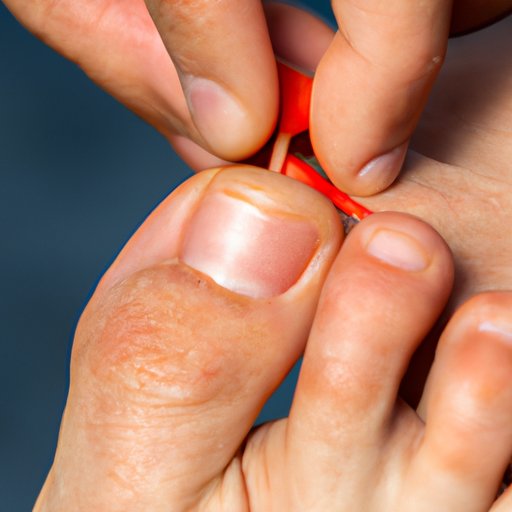
Introduction
A thick toe nail or onychomycosis is a common condition that affects many people. It is characterized by a thickening of the toenail, discoloration, and sometimes pain. There are many possible causes of a thick toe nail, including fungal infections, genetics, injuries, and poor hygiene. If left untreated, it can lead to further complications such as ingrown nails and infections. This article will discuss various home remedies, over-the-counter treatments, and professional options for addressing a thick toe nail problem.
Home remedies for thick toe nails
There are several natural ingredients that can be used to help treat a thick toenail. The following are some of the most effective:
Tea tree oil
Tea tree oil has antifungal and antibacterial properties and can help to kill the fungus or bacteria causing the thick nail. To use, mix tea tree oil with a carrier oil like olive oil and apply it to the affected nail twice a day. Make sure the mixture gets underneath the nail as well.
Vinegar
Vinegar is another natural remedy that has antifungal properties. Mix equal parts of vinegar and water and soak your feet for 15-20 minutes each day. Pat dry thoroughly afterwards.
Baking soda
Baking soda can help to exfoliate the skin and kill bacteria or fungus. Mix baking soda with water to form a paste and apply it to affected nails. Leave on for 10-15 minutes before rinsing off and drying thoroughly.
Importance of personal hygiene in preventing thick toenails
Practicing good personal hygiene is essential in preventing the development of thick nails. Here are some tips:
Causes of thick toenails
Thick toenails can be caused by a number of factors, including:
- Fungal infections
- Injury or trauma to the nail
- Genetics
- Diseases like diabetes
- Poor hygiene
Foot hygiene practices
Wash your feet regularly with soap and water, making sure to clean in between your toes. Dry your feet thoroughly afterwards, especially in between your toes. Moisture encourages the growth of bacteria and fungus.
Wearing breathable socks
Wear socks made from breathable materials like cotton or wool. Change your socks daily, or as soon as they become damp or sweaty.
Regular nail trimming
Trim your nails straight across and avoid cutting them too short or too round. This can lead to ingrown nails which can become infected and lead to thickening of the nail.
Over-the-counter treatments for thick toe nails
There are a number of over-the-counter treatments available for treating thick toenails. These include:
Overview of topical creams or ointments available
Antifungal creams and ointments can help to kill the fungus or bacteria causing the thick nail. Some common products include:
- Lamisil
- Lotrimin
- NailMax
Use and safety of OTC treatments
Follow the instructions carefully when using these products, and be aware of potential side effects. If you have underlying health conditions or are pregnant, make sure to consult a medical professional before using any OTC treatments.
Professional treatment options for thick toe nails
If home remedies and OTC treatments are not effective, you may need to seek professional help. There are several options available, including:
Overview of professional treatments
Laser therapy, electrocautery, and antifungal medication are all professional treatments that can be effective in treating thick toenails.
Laser therapy
Laser therapy is a non-invasive procedure that uses light energy to kill the fungus causing thick toenails. It is painless and requires no downtime.
Electrocautery
Electrocautery is a procedure where the nail is removed and an electric current is used to kill the fungus underneath. It is generally reserved for severe cases where other treatments have failed.
Antifungal medication
Antifungal medication can be prescribed by a doctor for severe or persistent cases of thick toenails. The medication is taken orally and works by killing the fungus causing the thick nail.
Benefits of professional trimming and care for thick toenails
Regular professional trimming and care can help to prevent the development of thick toenails. Some benefits include:
Pedicure and podiatrist services
Pedicure and podiatrist services can help to keep your toenails healthy and prevent thickening. A podiatrist can also provide treatment for underlying conditions, such as fungal infections, that may be causing thick nails.
Proper nail trimming techniques
A podiatrist can teach you proper nail trimming techniques to prevent ingrown nails and further complications.
Further advice on managing thick toenails
A podiatrist can also provide further advice on managing thick toenails, including which shoes to wear and how to maintain good foot hygiene practices.
Prevention and management of thick toe nails
Preventing and managing thick toenails requires a comprehensive approach. The following practices can help:
Comprehensive guide to preventing and managing thick toenails
To prevent and manage thick toenails:
- Practice good foot hygiene
- Eat a healthy diet
- Wear comfortable, breathable shoes
- Get regular exercise
- Seek professional help if necessary
Conclusion
Thick toenails are a common condition that can lead to further complications if left untreated. This article has provided an overview of home remedies, over-the-counter treatments, and professional options for addressing a thick toe nail problem. It has also outlined the importance of personal hygiene in preventing thick toenails, proper nail trimming techniques, and preventing and managing thick toenails. Remember to seek professional help if needed, and take a proactive approach to your foot health.





